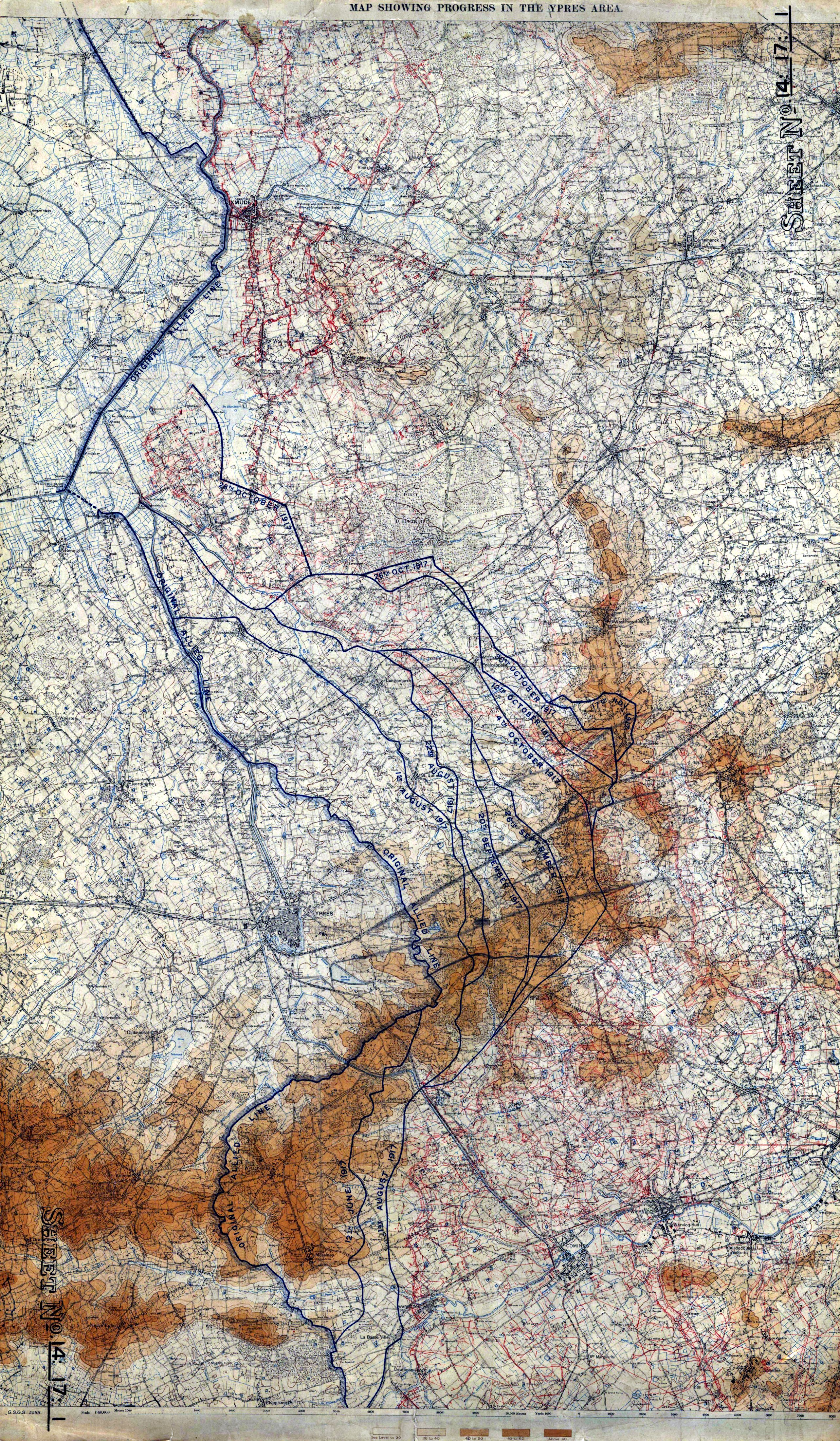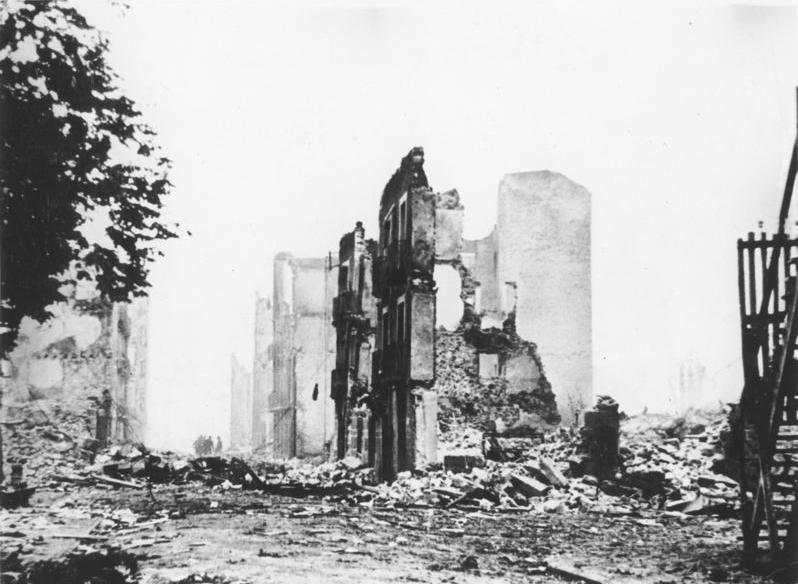|
Sunrise, Inverness Copse
''Sunrise, Inverness Copse'' is a 1918 watercolour by English artist Paul Nash, which was produced during World War I. It depicts a scene from the Western Front near Ypres in Belgium, and was developed from an eye-witness sketch which Nash drew whilst at the scene in 1917. The drawing is in the collection of the Imperial War Museum, in London. Artist Born in Kensington, London, England, in 1889, Paul Nash served in the Artists Rifles following the outbreak of World War I. He was subsequently commissioned as an officer in the Royal Hampshire Regiment. He was sent to Flanders in February 1917, but was invalided back to London in May 1917, a few days before his unit was nearly obliterated at the Battle of Messines. Nash became an official war artist and returned to the Ypres Salient, where he was shocked by the devastation caused by war. In six weeks on the Western Front, he completed what he called "fifty drawings of muddy places on the Front", one of which was ''Sunrise, Inve ... [...More Info...] [...Related Items...] OR: [Wikipedia] [Google] [Baidu] |
Paul Nash (artist)
Paul Nash (11 May 1889 – 11 July 1946) was a British surrealist painter and war artist, as well as a photographer, writer and designer of applied art. Nash was among the most important landscape artists of the first half of the twentieth century. He played a key role in the development of Modernism in English art. Born in London, Nash grew up in Buckinghamshire where he developed a love of the landscape. He entered the Slade School of Art but was poor at figure drawing and concentrated on landscape painting. Nash found much inspiration in landscapes with elements of ancient history, such as burial mounds, Iron Age hill forts such as Wittenham Clumps and the standing stones at Avebury in Wiltshire. The artworks he produced during World War I are among the most iconic images of the conflict. After the war Nash continued to focus on landscape painting, originally in a formalized, decorative style but, throughout the 1930s, in an increasingly abstract and surreal manner. In his ... [...More Info...] [...Related Items...] OR: [Wikipedia] [Google] [Baidu] |
Ypres Salient
The Ypres Salient around Ypres in Belgium was the scene of several battles and an extremely important part of the Western front during the First World War. Ypres district Ypres lies at the junction of the Ypres–Comines Canal and the Ieperlee. The city is overlooked by Kemmel Hill in the south-west and from the east by low hills running south-west to north-east with Wytschaete (Wijtschate), Hill 60 to the east of Verbrandenmolen, Hooge, Polygon Wood and Passchendaele (Passendale). The high point of the ridge is at Wytschaete, from Ypres, while at Hollebeke the ridge is distant and recedes to at Polygon Wood. Wytschaete is about above the plain; on the Ypres–Menin road at Hooge, the elevation is about and at Passchendaele. The rises are slight, apart from the vicinity of Zonnebeke, which has a From Hooge and to the east, the slope is near Hollebeke, it is heights are subtle but have the character of a saucer lip around Ypres. The main ridge has spurs sloping east an ... [...More Info...] [...Related Items...] OR: [Wikipedia] [Google] [Baidu] |
Paintings By Paul Nash
Painting is the practice of applying paint, pigment, color or other medium to a solid surface (called the "matrix" or "support"). The medium is commonly applied to the base with a brush, but other implements, such as knives, sponges, and airbrushes, can be used. In art, the term ''painting ''describes both the act and the result of the action (the final work is called "a painting"). The support for paintings includes such surfaces as walls, paper, canvas, wood, glass, lacquer, pottery, leaf, copper and concrete, and the painting may incorporate multiple other materials, including sand, clay, paper, plaster, gold leaf, and even whole objects. Painting is an important form in the visual arts, bringing in elements such as drawing, composition, gesture (as in gestural painting), narration (as in narrative art), and abstraction (as in abstract art). Paintings can be naturalistic and representational (as in still life and landscape painting), photographic, abstract, narrative, sy ... [...More Info...] [...Related Items...] OR: [Wikipedia] [Google] [Baidu] |
1918 Paintings
This year is noted for the end of the First World War, on the eleventh hour of the eleventh day of the eleventh month, as well as for the Spanish flu pandemic that killed 50–100 million people worldwide. Events Below, the events of World War I have the "WWI" prefix. January * January – 1918 flu pandemic: The "Spanish flu" ( influenza) is first observed in Haskell County, Kansas. * January 4 – The Finnish Declaration of Independence is recognized by Soviet Russia, Sweden, Germany and France. * January 9 – Battle of Bear Valley: U.S. troops engage Yaqui Native American warriors in a minor skirmish in Arizona, and one of the last battles of the American Indian Wars between the United States and Native Americans. * January 15 ** The keel of is laid in Britain, the first purpose-designed aircraft carrier to be laid down. ** The Red Army (The Workers and Peasants Red Army) is formed in the Russian SFSR and Soviet Union. * January 18 - The Historic Co ... [...More Info...] [...Related Items...] OR: [Wikipedia] [Google] [Baidu] |
Guernica (Picasso)
''Guernica'' (; ) is a large 1937 oil painting by Spanish artist Pablo Picasso.Richardson (2016)Picasso, Pablo. Guernica.' Museo Reina Sofía. ''(Retrieved 2017-09-07.)'' It is one of his best-known works, regarded by many art critics as the most moving and powerful anti-war painting in history. It is exhibited in the Museo Reina Sofía in Madrid. The grey, black, and white painting, on a canvas tall and across, portrays the suffering wrought by violence and chaos. Prominent in the composition are a gored horse, a bull, screaming women, a dead baby, a dismembered soldier, and flames. Picasso painted ''Guernica'' at his home in Paris in response to the 26 April 1937 bombing of Guernica, a Basque Country town in northern Spain that was bombed by Nazi Germany and Fascist Italy at the request of the Spanish Nationalists. Upon completion, ''Guernica'' was exhibited at the Spanish display at the 1937 Paris International Exposition, and then at other venues around the world. T ... [...More Info...] [...Related Items...] OR: [Wikipedia] [Google] [Baidu] |
Richard Cork
Richard Cork (born 25 March 1947) is a British art historian, editor, critic, broadcaster and exhibition curator. He has been an art critic for the ''Evening Standard'', '' The Listener'', ''The Times'' and the ''New Statesman''. Cork was also editor for Studio International. He is a past Turner Prize judge. Early life Richard Cork was educated at Kingswood School, Bath (1960–1964). He read art history at the University of Cambridge and was awarded his doctorate in 1978. Career Cork was Slade Professor of Fine Art at Cambridge from 1980–90, and the Henry Moore Senior Fellow at the Courtauld Institute of Art in London from 1992–95. He then served as Chair of the Visual Arts Panel at the Arts Council of England until 1998. Committees he has sat on have included that of the Hayward Gallery, the British Council's Visual Art Committee and the Advisory Council for the Paul Mellon Centre for Studies in British Art. He has also been on the panel of judges for the Turner Prize a ... [...More Info...] [...Related Items...] OR: [Wikipedia] [Google] [Baidu] |
Google Arts & Culture
Google Arts & Culture (formerly Google Art Project) is an online platform of high-resolution images and videos of artworks and cultural artifacts from partner cultural organizations throughout the world. It utilizes high-resolution image technology that enables the viewer to tour partner organization collections and galleries and explore the artworks' physical and contextual information. The platform includes advanced search capabilities and educational tools. A part of the images are used within Wikimedia and Wikipedia. Collections in Wikimedia The following list of collections is based on the Wikimedia category Google Art Project works by collection. The "Visit" link redirects to the museum's official page on the Google Arts & Culture platform. See alscollections in Google Arts & Culture The "Assigned works" link redirects to the images of the works shown in this collection available in Wikimedia. Painters in Wikimedia The following alphabetically ordered list of painters ... [...More Info...] [...Related Items...] OR: [Wikipedia] [Google] [Baidu] |
Battle Of Passchendaele
The Third Battle of Ypres (german: link=no, Dritte Flandernschlacht; french: link=no, Troisième Bataille des Flandres; nl, Derde Slag om Ieper), also known as the Battle of Passchendaele (), was a campaign of the First World War, fought by the Allies against the German Empire. The battle took place on the Western Front, from July to November 1917, for control of the ridges south and east of the Belgian city of Ypres in West Flanders, as part of a strategy decided by the Allies at conferences in November 1916 and May 1917. Passchendaele lies on the last ridge east of Ypres, from Roulers (now Roeselare), a junction of the Bruges-(Brugge)-to-Kortrijk railway. The station at Roulers was on the main supply route of the German 4th Army. Once Passchendaele Ridge had been captured, the Allied advance was to continue to a line from Thourout (now Torhout) to Couckelaere (Koekelare). Further operations and a British supporting attack along the Belgian coast from Nieuport ( Nieuwpoo ... [...More Info...] [...Related Items...] OR: [Wikipedia] [Google] [Baidu] |
London
London is the capital and largest city of England and the United Kingdom, with a population of just under 9 million. It stands on the River Thames in south-east England at the head of a estuary down to the North Sea, and has been a major settlement for two millennia. The City of London, its ancient core and financial centre, was founded by the Romans as '' Londinium'' and retains its medieval boundaries.See also: Independent city § National capitals The City of Westminster, to the west of the City of London, has for centuries hosted the national government and parliament. Since the 19th century, the name "London" has also referred to the metropolis around this core, historically split between the counties of Middlesex, Essex, Surrey, Kent, and Hertfordshire, which largely comprises Greater London, governed by the Greater London Authority.The Greater London Authority consists of the Mayor of London and the London Assembly. The London Mayor is distinguished fr ... [...More Info...] [...Related Items...] OR: [Wikipedia] [Google] [Baidu] |
Battle Of Messines (1917)
The Battle of Messines (7–14 June 1917) was an attack by the British Second Army (General Sir Herbert Plumer), on the Western Front, near the village of Messines (now Mesen) in West Flanders, Belgium, during the First World War. The Nivelle Offensive in April and May had failed to achieve its more grandiose aims, had led to the 1917 French Army mutinies, demoralisation of French troops and confounded the Anglo-French strategy for 1917. The attack forced the Germans to move reserves to Flanders from the Arras and Aisne fronts, relieving pressure on the French. The British tactical objective was to capture the German defences on the ridge, which ran from Ploegsteert Wood (Plugstreet to the British) in the south, through Messines and Wytschaete to Mt Sorrel, depriving the German 4th Army (German Empire), 4th Army of the high ground. The ridge gave commanding views of the British defences and back areas of Ypres to the north, from which the British intended to conduct the North ... [...More Info...] [...Related Items...] OR: [Wikipedia] [Google] [Baidu] |
_(Art._IWM_ART_1154).jpg)





